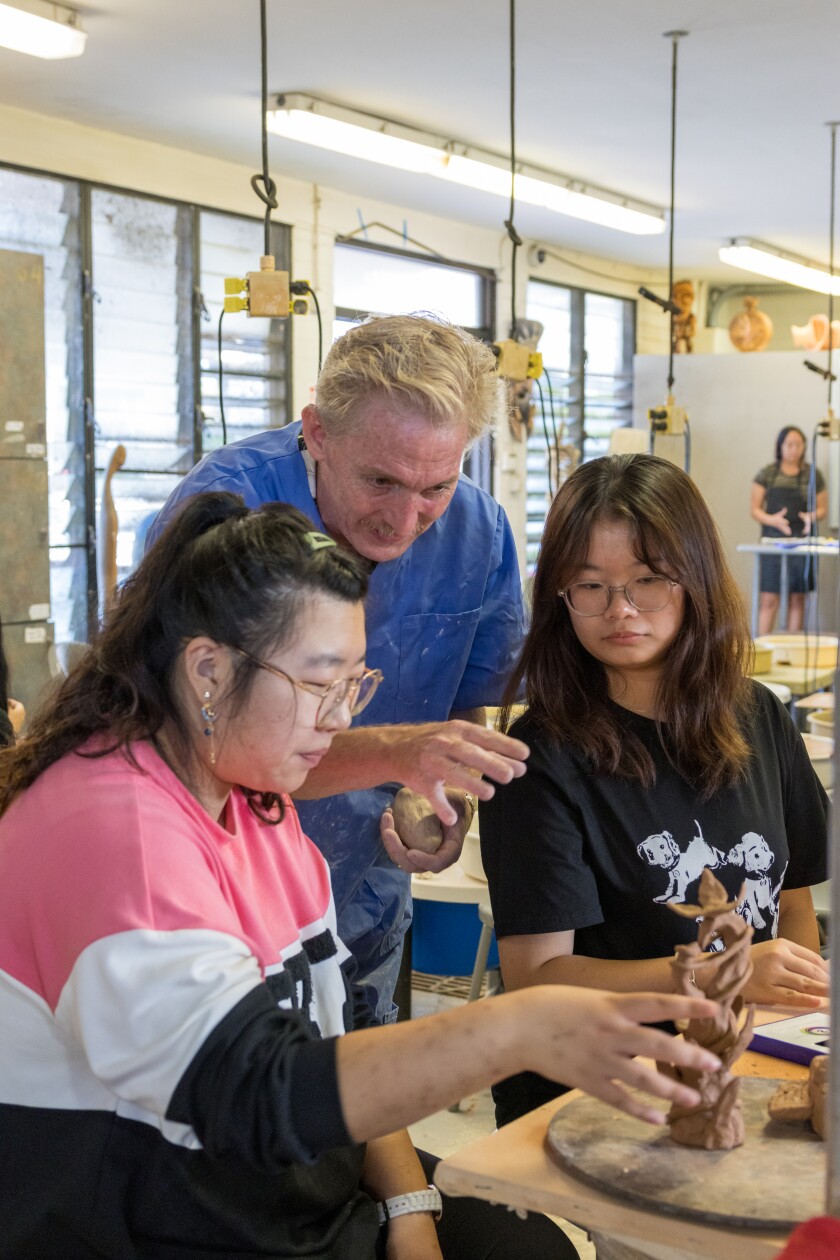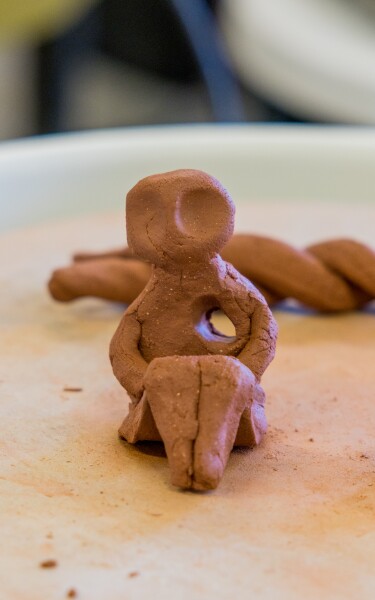Students and a professor share their experiences of trying and teaching clay therapy in a creative arts therapy psychology class

As a part of her creative arts therapy class she sculpted a small figure sitting down with its legs curled up to its chest, arms wrapped around and the head bowed, said Maile Bachelor, a junior from Chicago majoring in psychology. She also formed a braid, which she said represents a rope, and sketched another figure whose arms are wrapped around the other person to show the individual is feeling weighed down.
She explained this piece depicts someone who is heavily burdened and said it represents support networks that have helped get her personally through challenges. Further, she said the braid was added to resemble a bridge and as an expression of all the relationships and support systems she had. Clay therapy gives Bachelor a safe space to express her feelings and emotions, she said.
Purpose
The Psychology Department developed the creative arts therapy class to help students become more aware of their unconsciousness, said Dr. Eric Orr, an assistant professor in the Faculty of Sciences and a licensed clinical psychologist.
He explained the purpose of the class is to provide students with the experience of practicing different therapeutic approaches within creative and expressive arts. Some of the creative practices in this class include poetry therapy, play therapy, sand tray therapy, dance/movement therapy, drama and psychodrama therapy, music therapy and body mapping.
According to Orr, the art form of clay therapy offers a medium for people to work with difficulties such as anger, sorrow, fear and progress in their therapeutic process.
He explained the current psychotherapy course in the psychology program is heavily focused on western models of practice. Orr said many of the western approaches aren't very conducive to working with people from the Asia Pacific region. Therefore, he wanted to give the students an opportunity to understand other therapeutic approaches that are not based on the western model.
Orr said, at times, western talk therapy can be difficult. However, he explained, “If I can engage a person in working with clay or with some art, [such as] drawings or something of that nature, then when they talk about this thing that's outside of themselves, it's much easier for them to do. I think it's a very important exposure for our students, especially those who are going to return to Asia or the Pacific Islands,” said Orr.
From his experience, he said people from Asia and the Pacific Islands are not as expressive when it comes to sharing their problems and difficulties in regard to mental health. Thus, exposing students to this approach early in their careers, Orr said, will open up their minds to not being culturally encapsulated. He explained this helps students understand it's not just the western approaches that are going to be useful but other approaches that might be even more beneficial.
Orr said he believes this program is more necessary than regular psychotherapy for students who wish to return to their home countries.
Experiencing clay art
AryLue Jones, a junior from Idaho majoring in painting and illustration, said, “It was honestly surprising how therapeutic it ended up being, because I didn't know what I was making originally. Then once I made it, I was like this is what I'm feeling.” Jones said it showed a physical representation of the things that were spiraling in her mind as she was creating it.
“I created a little bowl kind of thing and these long creepy looking figures. There's a little figure in the middle that is meant to represent me. These are figures that interpret my inner demons, my inner self-critic. Sometimes it can be so overwhelming that it's surrounding me, and I spiral up which is why that little figure represents me being curled up in a ball,” said Jones.
She explained it reminded her of the times when she would have panic attacks and all her emotions, and her inner critic and demons would start overpowering, making her feel like she was sinking lower. Jones said she gets so many emotions she can never put them into words so it was easier to form it into a physical representation. She said this helped her find the words for what she had been feeling.
Yining Yang, a sophomore psychology major from China, said, “I feel like this therapy is not just for learning the knowledge but also to express our feelings.” She said she is more engaged in class through this clay therapy, and she has more time to ponder about herself.
Significance of clay therapy
Orr said this class is intended to help assist students to have a comprehensive grasp of therapy by applying the ideas they are learning in this course to a variety of different areas. A lot of concepts from this class are difficult to discern, thus, having a hands-on demonstration will help students to learn the vocabulary smoother, said Orr.
“I think this process has been happening for thousands of years. We used to make things together as families. We used to work on crafts and arts as a group and as a village. So, this isn't new stuff, but now we're couching it in terms of therapy because of the necessities of modern day life,” said Orr.
He said he hopes students from this class will liken to themselves the therapy forms similar to how they liken the scriptures unto themselves, as it is something they can carry throughout their life and even in their future families. Orr said this class was designed with the expectation students are going to be uncomfortable at times because it involves changing their schema or they way they understand mental theory.
Students do not have to participate if they are uncomfortable, and it does not affect their grades in any manner. They always have the option to sit back and watch other students engage in the class, Orr said.
“Some people are going to be uncomfortable, and I'm okay with that. I hope many of my students in many of my classes are uncomfortable because they will get challenged by this new information. Then they'll have to decide what to do with it next. I do care very much for the students who might discover some things that are very difficult and might kind of tip them over a little bit,” expressed Orr.
He highly encouraged students to make use of Counseling Services and utilize the resources they provide. Being a licensed clinical psychologist, Orr said he understands and respects when students get triggered and said he is willing to work with them to keep them safe and protected.
Student’s recommendations
Jones said she has been involved in a lot of artistic experiences, and she has found this clay therapy a fun alternative way to express herself. “There's so much stigma around therapy, and it has so many negative connotations in my experience. This was a fun way to get me out of my head,” Jones said.
Bachelor said she wants to be a therapist and would use this clay therapy in the future as she knows how valuable it can be for a lot of people. “I think everyone should [take the class]. It's a really good chance to reconnect with yourself, discover your creative side and just really bring out things you didn't know were there,” said Bachelor.
She continued, “It's a chance to let loose, and I think it's nice because in most of your classes, you go there and you'll just listen to a lecture, and it's super serious. So, I like that this class lets you relax and have fun.”
Yang invited others to experience this clay therapy for themselves as she said it is very therapeutic and brings lots of joy. The students said the class gave them a sense of awareness of who they are.


